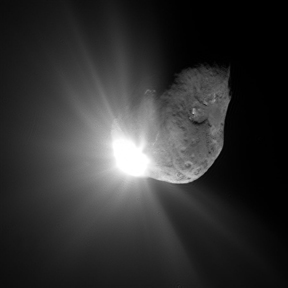 On July 4,
astronomers around the world held their breaths and watched the fireworks as
a washing-machine-sized space-craft pummeled comet Tempel 1. The collision was
part of NASA’s Deep Impact mission, which aimed to excavate material so
that researchers could take a peek at the interior of a comet for the first
time (see Geotimes, July 2005).
On July 4,
astronomers around the world held their breaths and watched the fireworks as
a washing-machine-sized space-craft pummeled comet Tempel 1. The collision was
part of NASA’s Deep Impact mission, which aimed to excavate material so
that researchers could take a peek at the interior of a comet for the first
time (see Geotimes, July 2005).The Deep Impact mission’s flyby craft captured this image of Tempel 1 67 seconds after impact. Light reflected from debris blocks any view of the impact crater, but the rest of the surface, which researchers now say is powdery, is visible. Image courtesy of NASA/JPL-Caltech/UMD.
It took only days for the dust to clear, and the comet continued along its orbit as if nothing happened. It took weeks, however, of lengthy analysis for researchers to make sense of the abundant data. Results were released in September in six Science Express papers, with contributions from scientists worldwide. Researchers say that among other results, they have determined that the comet is loosely held together and contains vast amounts of ethane in its interior.
Prior to Deep Impact, no one knew if the nucleus of Tempel 1 was held together tightly or loosely by gravity and ice, or if it had a smooth or rough surface. Even its composition remained a mystery, including whether or not organic materials were present and in what quantities.
To address these uncertainties, telescopes on the ground and devices in space took images of Tempel 1 before, during and after the “controlled” impact. “The day before the encounter, we had one picture of what a comet was like, and the next day it was completely different,” says Peter Schultz, a Deep Impact co-investigator from Brown University in Rhode Island.
Images taken prior to the impact revealed to researchers that much of the surface is heavily cratered, but there are also regions with curious smooth sections of newer layered materials that have filled and covered old craters. “The mystery, though, is what process resurfaces the comet,” Schultz says. Some active geological process is occurring, he says, “not in the sense of eruptions or flow,” but something that has acted to deposit new materials.
Researchers also closely watched the seconds following the impact, when about 10 million kilograms of dust were excavated. Unfortunately, the dense plume of small particles obscured any view of the impact crater. But not all was lost — based on the size of the plume and the amount of material ejected, researchers estimated limits for the diameter of the crater between 100 and 200 meters.
The large plume also helped confirm the idea that gravity holds together the comet very weakly, allowing it to break up easily. A powdery dust layer, up to tens of meters deep, covers much of the comet. Researchers could look at the plume and indirectly estimate the density of the comet, Schultz says. His team found that the density was about 60 percent that of ice. “Another way to look at it is like fluffy snow,” Schultz says.
The fluffy surface was also confirmed when researchers found that the surface of Tempel 1 could heat up and cool down rapidly, “and that only happens when you get very fine grains on the surface,” Schultz says. Temperature measurements revealed that surfaces in the path of direct sunlight heated quickly, but when the region moved into a shadow, surfaces quickly became very cold. Schultz says, however, that the surface layer might be more powdery than the interior of the comet.
Within the interior of Tempel 1, another surprise awaited NASA Goddard Spaceflight Center researcher Michael Mumma and colleagues. Using observations from the Keck telescope at Mauna Kea, Hawaii, they analyzed the gases released by the impact over time to determine the relative abundances of organic materials in various layers. They hoped that analysis of the comet’s chemical composition could help them determine where in the early solar system it had formed.
One particularly interesting find was that ethane was more abundant in the sampled part of the interior than at the surface. Mumma says that if the ethane measurement holds true for the entire interior, then Tempel 1 is similar in composition to many comets from a distant reservoir called the Oort Cloud. But based on its current orbit, Tempel 1 is thought to have moved inward from the Kuiper Belt, so their findings suggest that comets in these two wildly different locales likely originated in a common region of the disk of debris that eventually formed the planets.
Further investigation will likely turn up more clues, as researchers have only started to sift through the data uncovered from the Deep Impact crater. The impact “virtually took a shovel, and dug deep, and brought up material so we can look at it,” Schultz says. “This is the beginning of cometary geology.”

